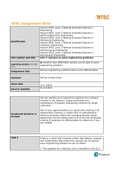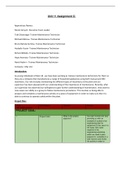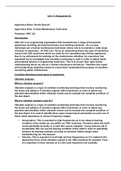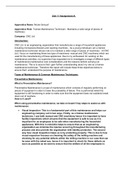PEARSON (PEARSON) • Engineering 2016/2017 NQF
Latest uploads for Engineering 2016/2017 NQF at PEARSON (PEARSON). Looking for Engineering 2016/2017 NQF notes at PEARSON (PEARSON)? We have lots of notes, study guides and revision notes available for Engineering 2016/2017 NQF at PEARSON (PEARSON).
-
129
- 0
-
19
Modules Engineering 2016/2017 NQF at PEARSON (PEARSON)
Notes available for the following courses of Engineering 2016/2017 NQF at PEARSON (PEARSON)
- Unit 1 - Engineering Principles Eng 14
- Unit 10 - Computer Aided Design in Engineering 2
- Unit 11 - Engineering Maintenance and Condition Monitoring Techniques 3
- Unit 19 - Electronic Devices and Circuits 6
- Unit 2 - Delivery of Engineering Processes Safely as a Team UHJ85A 21
- Unit 21 - Electronic Measurement and Testingof Circuits 2
- Unit 22 - Electronic Printed Circuit Board Design and Manufacture 1
- Unit 25 - Mechanical Behaviour of Metallic Materials 7
- Unit 25: Mechanical Behaviors of Metallic Material 1
- Unit 27 - Static Mechanical Principles in Practice 3
- Unit 3 - Engineering Product Design and Manufacture 3
- Unit 35 - Computer Programming 1
- Unit 39 - Modern Manufacturing Systems 4
- Unit 4 - Applied Commercial and Quality Principles in Engineering 15
- Unit 40 - Computer Aided Manufacturing and Planning UHJ85A 4
- Unit 41 - Manufacturing Secondary Machining Processes 4
- Unit 42 - Manufacturing Primary Forming Processes 1
- Unit 43 - Manufacturing Computer Numerical Control Machining Processes 5
- Unit 45 - Additive Manufacturing Processes 7
- Unit 47 - Composites Manufacture and Repair Processes 6
- Unit 5 - A Specialist Engineering Project 7
- Unit 6 - Microcontroller Systems forEngineers 3
- Unit 7 - Calculus to Solve Engineering Problems 6
- Unit35: planning the development of a software 1
Popular books PEARSON (PEARSON) • Engineering 2016/2017 NQF
Latest notes & summaries PEARSON (PEARSON) • Engineering 2016/2017 NQF
Your informal report should contain: ● analysis ● worked solutions to the problems Each worked solution should be laid out clearly and contain brief explanations of the stages of the calculation to indicate your understanding of how calculus can be used to solve an engineering problem. You explanation should be detailed in response to questions 9 and 10 to show how the variables are optimised in each case. Graphs should be well presented and clearly labelled and comparisons between methods...
Unit 11 Assignment C -Distinction
Unit 11 Assignment B-Distinction
Unit 11 Assignment A-Distinction
Unit 4 Distinction Assignments
Unit 4 Distinction Assignments
Unit 4 Distinction Assignments













